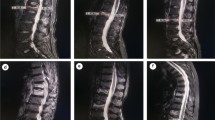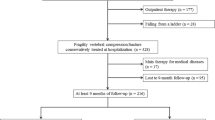Abstract
Background
The majority of multiple vertebral fractures (MVFs) occur under high-energy conditions; however, some cases occurring under minor-energy conditions exist. Fractures in successive vertebrae (continuous type) and in skipped vertebrae (discontinuous type) can exist.
Purpose
The objective of this study was to compare and evaluate the cause, level of injury, and relationship to osteoporosis between continuous and discontinuous MVFs.
Methods
We studied 77 subjects (173 vertebrae) who had presented with acute back pain between September 2007 and April 2010 and who received diagnoses of fresh MVFs through magnetic resonance imaging. Subjects with continuous and discontinuous fractures were evaluated based on age, sex, bone mineral density (BMD), level of affected vertebrae, and cause of injury.
Results
Subjects with discontinuous MVFs were significantly older and comprised more female patients. Mean BMD, measured by dual-emission X-ray absorptiometry, was 0.70 and 0.58 g/cm3 for the continuous and discontinuous MVFs, respectively, demonstrating a significant difference. Of 34 patients with discontinuous MVFs, 32 (94%) exhibited vertebral fractures in the thoracolumbar junction. In subjects with continuous MVFs, the MVFs of 19 (44%) subjects were caused by high-energy trauma, whereas mild trauma and unknown cause were identified in 14 (41%) and 13 (38%) subjects with discontinuous MVFs, respectively.
Conclusions
Discontinuous MVFs generally caused by mild outer force, and often occurred at the thoracolumbar junction. Continuous MVFs, frequently, were caused by high-energy trauma.



Similar content being viewed by others
References
Cooper C, Atkinson EJ, O’Fallon WM, Melton LJ III (1992) Incidence of clinically diagnosed vertebral fractures: a population-based study in Rochester, Minnesota 1985–1989. J Bone Miner Res 7:221–227
Heaney RP (1992) The natural history of vertebral osteoporosis: is low bone mass an epiphenomenon? Bone 13:S23–S26
Leech JA, Dulberg C, Kellie S, Pattee L, Gay J (1990) Relationship of lung function to severity of osteoporosis in women. Am Rev Respir Dis 141:68–71
Cook DJ, Guyatt GH, Adachi JD, Clifton J, Griffith LE, Epstein RS et al (1993) Quality of life issues in women with vertebral fractures due to osteoporosis. Arthritis Rheum 36:750–756
Lyles KW, Gold DT, Shipp KM, Pieper CF, Martinez S, Mulhausen PL (1993) Association of osteoporotic vertebral fractures with impaired functional status. Am J Med 94:595–601
Silverman SL (1992) The clinical consequences of vertebral compression fracture. Bone 13:S27–S31
Kado DM, Browner WS, Palermo L, Nevitt MC, Genant HK, Cummings SR (1999) Vertebral fractures and mortality in older women: a prospective study. Arch Intern Med 159:1215–1220
Baker LL, Goodman SB, Perkash I et al (1990) Benign versus pathologic compression fractures of vertebral bodies: assessment with conventional spin-echo, chemical-shift, and STIR MR imaging. Radiology 174:495–502
Nakano T (2006) Diagnosis of vertebral compression fractures. Orthop Traumatol 49:771–778
Ichimura S (2000) Pathology of osteoporotic vertebral compression fracture and MRI. Spine Spinal Cord 13:515–523
Black DM, Cummings SR, Karpf DB et al (1996) Randomised trial of effect of alendronate on risk of fracture in women with existing vertebral fractures: Fracture Intervention Trial Research Group. Lancet 348:1535–1541
Vogt TM, Ross PD, Palermo L et al (2000) Vertebral fracture prevalence among women screened for the fracture intervention trial and a simple clinical tool to screen for undiagnosed vertebral fracture: Fracture Intervention Trial Research Group. Mayo Clin Proc 75:888–896
Ito M (2003) Biomechanics of vertebral compression fractures. Spine Spinal Cord 16:927–932
Wasnich U (1996) Vertebral fracture epidemiology. Bone 18:1791–1796
Conflict of interest
None of the authors of this manuscript has received any type of support, benefits, or funding from commercial party related directly or indirectly to the subject of this article.
Author information
Authors and Affiliations
Corresponding author
Rights and permissions
About this article
Cite this article
Kano, S., Tanikawa, H., Mogami, Y. et al. Comparison between continuous and discontinuous multiple vertebral compression fractures. Eur Spine J 21, 1867–1872 (2012). https://doi.org/10.1007/s00586-012-2210-6
Received:
Revised:
Accepted:
Published:
Issue Date:
DOI: https://doi.org/10.1007/s00586-012-2210-6




